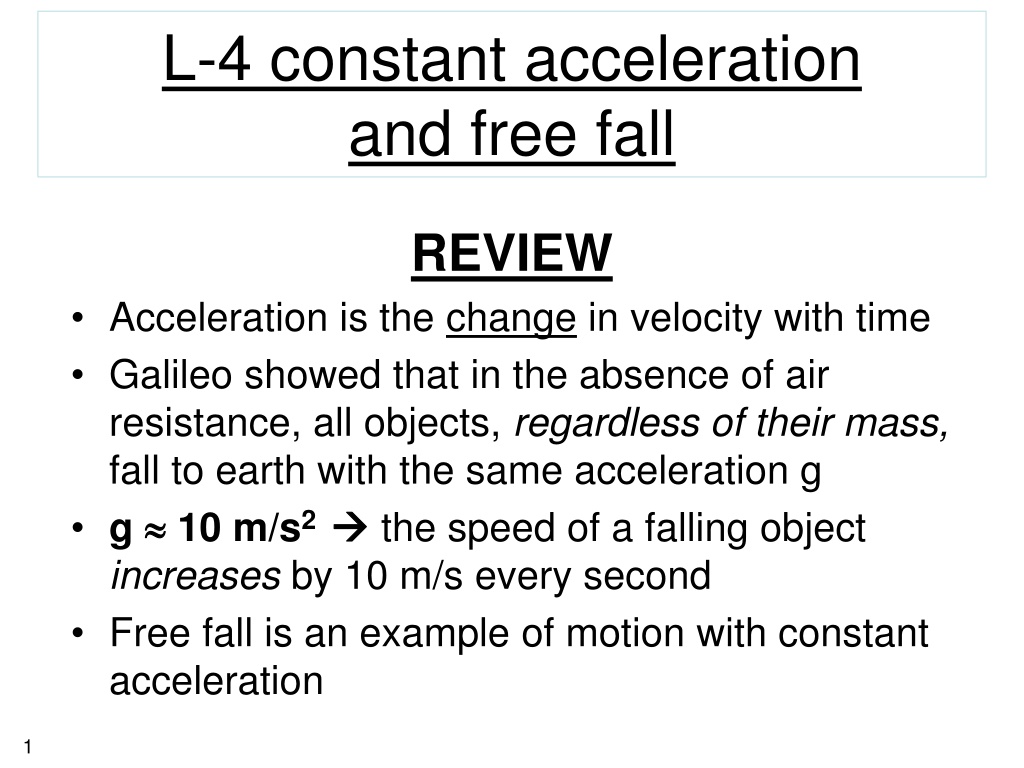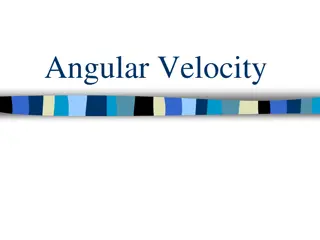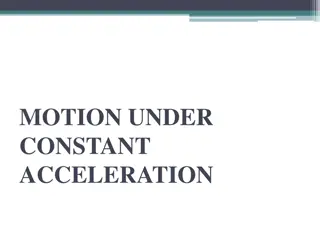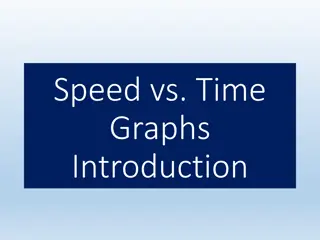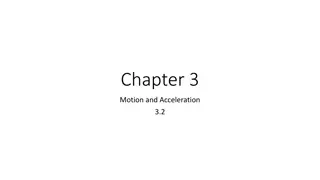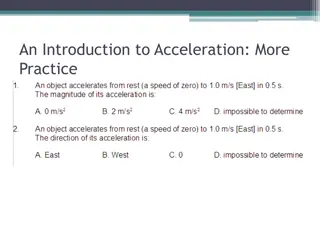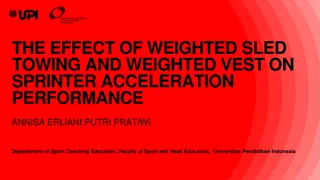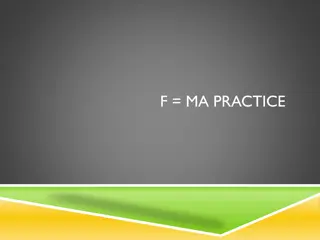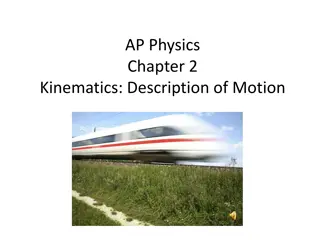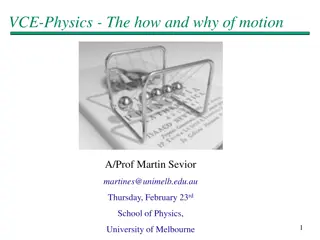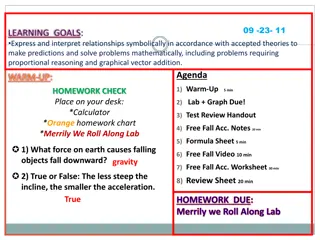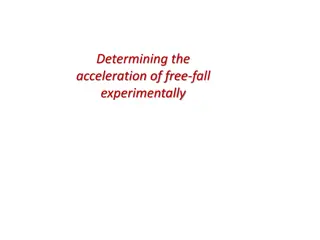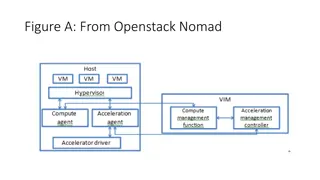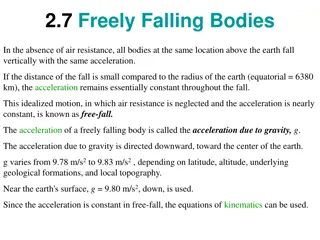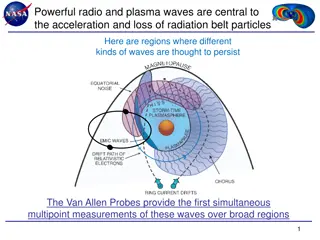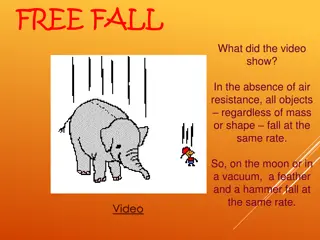Constant Acceleration and Free Fall
Acceleration is the rate of change in velocity with time. In free fall, all objects fall to Earth with the same acceleration regardless of mass. This review covers motion with constant acceleration, including examples and explanations of velocity changes and simple cases with zero acceleration.
Download Presentation

Please find below an Image/Link to download the presentation.
The content on the website is provided AS IS for your information and personal use only. It may not be sold, licensed, or shared on other websites without obtaining consent from the author.If you encounter any issues during the download, it is possible that the publisher has removed the file from their server.
You are allowed to download the files provided on this website for personal or commercial use, subject to the condition that they are used lawfully. All files are the property of their respective owners.
The content on the website is provided AS IS for your information and personal use only. It may not be sold, licensed, or shared on other websites without obtaining consent from the author.
E N D
Presentation Transcript
L-4 constant acceleration and free fall REVIEW Acceleration is the change in velocity with time Galileo showed that in the absence of air resistance, all objects, regardless of their mass, fall to earth with the same acceleration g g 10 m/s2 the speed of a falling object increases by 10 m/s every second Free fall is an example of motion with constant acceleration 1
Motion with constant acceleration acceleration is the rate at which the velocity changeswith time (increases or decreases) acceleration is measured in distance units divided by (time)2, for example: m/s2, cm/s2, ft/s2 We will see how the velocity of an object changes when it experiences constant acceleration. First, we ll consider the simplest case where the acceleration is zero, so that the velocity is constant. 2
Simplest case: constant velocity (a=0) If a = 0, then the velocity v is constant. In this case the distance xf an object will travel in a certain amount of time t is given by distance = velocity x time xf = xi + v t (for a = 0) xi is the starting (initial) position, and xf is the final position. 3
Example: constant velocity (a = 0) A car moves with a constant velocity of 25 m/s. How far will it travel in 4 seconds? Solution: Suppose we take the starting point xi as zero. (We can put x = 0 wherever we like). Then, xf = 0 + vt = 0 + (25 m/s)(4 s) = 100 m 4
The 100 m dash Usain Bolt in 2009 set a new world record ( ) in the 100 m dash at 9.58 s. Did he run with constant velocity, or was his motion accelerated? Initially at the starting line he was not moving (at rest), then he began moving when the gun went off, so his motion was clearly accelerated Although his average speed was about 100 m/10 s = 10 m/s, he did not maintain this speed during the entire race. 5
100 m dash -- Seoul 1988 100 m dash Rome 1988 12 10 Ben Johnson Carl Lewis Florence Griffith Joyner 8 Ben Johnson Carl Lewis Fl-G-Joyner 6 4 2 0 0 20 40 distance (meters) 60 80 100 6
How to calculate acceleration Example: Starting from rest, a car accelerates up to 50 m/s (112 mph) in 5 sec. Assuming that the acceleration was constant, compute the acceleration. Solution: acceleration (a) = rate of change of velocity with time change in velocity time interval 50m/s-0m/s 5 s - 0 s final velocity- initial velocity final time-initial time 50 m/s = 10 m/s 5 s a= = 2 = = 7
Motion with Constant acceleration Suppose an object moves with a constant acceleration a. If at t = 0 its initial velocity is (vi), then we want to know what its final velocity (vf) be after a time t has passed. final velocity = initial velocity + acceleration time vf = vi + a t (for constant acceleration) a t is the amount by which the velocity increases from vi to vf after a time t. Note that if a = 0, vf = vi, i.e., velocity is constant. 8
Example: constant acceleration A car moving initially at vi = 3 m/s begins accelerating with a = 2 m/s2. What is its velocity at t = 5 s? Solution: vf = vi + a t = 3 m/s + 2 m/s2 5 s = 3 m/s + 10 m/s = 13 m/s 9
Example deceleration slowing down Deceleration means that the acceleration is opposite in direction to the velocity Suppose you are moving at vi 15 m/s and apply the brakes. The brakes provide a constant deceleration of 5 m/s2. How long will it take the car to stop? vf = vi + a t 0 = 15 m/s + ( 5 m/s2) t 0 = 15 5t 5t = 15 t = 15/5 = 3 s 10
Free Fall: Motion with constant acceleration According to Galileo, in the absence of air resistance, all objects fall to earth with a constant acceleration a = g 10 m/s2 g is the special symbol we use for the acceleration due gravity. Since we know how to deal with constant acceleration, we can also solve problems involving free fall. 11
Free fall velocity and distance time (s) 0 1 2 3 4 5 velocity (m/s) 0 10 20 30 40 50 distance y (m) 0 = 10 (0)2 5 = 10 (1)2 20 = 10 (2)2 45 = 10 (3)2 80 = 10 (4)2 125 = 10 (5)2 If we observe an object falling from the top of a building we find that it gains speed as it falls Every second, its speed increases by 10 m/s. We also observe that it does not fall equal distances in equal time intervals. The formula in the right column was discovered by Galileo. 12
Ball dropped from rest If the ball is dropped from rest, that means that its initial velocity is zero, vi = 0 Then its final velocity after a time t is vf = a t, where a = g 10 m/s2 so, vf = g t Example: What is the velocity of a ball 5 sec. after it is dropped from rest from the top of the Sears Tower (Willis Tower)? Solution: vf = g t = 10 m/s2 5 s = 50 m/s (about 112 mph) 13
Relationship between time and distance in free fall It would be useful to know how long it would take for an object, dropped from rest, to fall a certain distance For example, how long would it take an object to fall to the ground from the top of the Sears Tower, a distance of 442 m? Or, after a certain time, how far will an object, dropped from rest, have fallen? 14
Falling distance Suppose an object falls from rest so its initial velocity vi = 0. After a time t the ball will have fallen a distance: yf = acceleration time2 yf = g t2 (This is the formula Galileo found.) For vertical motion, we use the symbol y for distance; for horizontal motion we use x. 15
Falling from the Sears Tower Example: How far would a ball dropped from rest at the top of the Sears Tower fall in 5 seconds? Solution: yf = 10 m/s2 (5 s)2 = 5 25 = 125 m (about 410 feet) 16
Time to reach the ground Another interesting question, is how long it will take an object, dropped from rest from the top of the Sears Tower (442 m) take to reach the ground? To answer this question we need to solve the time-distance formula for t 1 y = gt 2y = gt 2 2y g 2y g 2 2 2 t = t = f f f f 2 442 10 884 10 So: t = = = 88.4 = 9.4 s. 17
Velocity as object hits the ground Q: How fast will the object be moving when it hits the ground? A: We apply the velocity time relation vf = vi + g t, with vi = 0. vf = g t = 10 m/s2 9.4 s = 94 m/s or about 210 mph (neglecting air resistance) 18
Time to go up Suppose a ball is thrown straight up with a speed vi. When does it reach its maximum height? As it rises, it slows down (decelerates) because gravity is pulling it down. At its maximum height vf = 0 (We say that it is instantaneously at rest). vf = vi + a t applies whether an object is falling or rising. On the way down it speeds up, so adown = +g = 10m/s2; on the way up, it slows down, so aup = g = 10m/s2 Since vf = 0 at the top, then we have: vf = 0 = vi + ( g) t, so tup = vi / g (time to max. height) 19
Example A volleyball player can jump straight up at 5 m/s. How long is she in the air? Solution: total time = ttotal = tup + tdown time for her to get to top = tup = vi / g where vi is her initial upward velocity tup = 5 m/s / 10 m/s2 = sec. It takes exactly the same amount of time to reach the top as it does to return to the ground, or tup = tdown, so ttotal = s + s = 1 s (This is the amount of time that she is in the air.) 20
Escape from planet earth To escape from the gravitational pull of the earth an object must be given a velocity larger than the so called escape velocity For earth the escape velocity is 7 mi/sec or 11,000 m/s, 11 kilometers/sec or about 25,000 mph. An object given at least this velocity on the earth s surface can escape from earth! The Voyager 2 spacecraft, launched on Aug. 20, 1977, recently left the solar system and is the first human-made object to reach interstellar space. 21
